In our daily lives, we often overlook the invisible threats that lurk in various environments, posing significant health risks. These dangers, known as biohazards, range from viruses to toxic chemicals, all requiring meticulous attention to ensure our safety. At the forefront of this essential safety measure are biohazard cleaning companies. These specialized teams play a crucial role in cleaning and safeguarding public health by managing these risks effectively.
Biohazards encompass a broad spectrum of biological substances that pose threats to human health and the environment. The importance of recognizing and properly handling these materials cannot be overstated. With the rise of infectious diseases and chemical exposures, the need for biohazard cleaners has become more critical than ever. These professionals are trained to tackle various hazardous situations, ensuring that the risks associated with these dangerous substances are minimized.
The Critical Role of Biohazard Cleaning Companies
Biohazard cleaning companies are the unsung champions in the fight against biological and chemical threats. Equipped with specialized knowledge and tools, they ensure that environments contaminated by biohazards are thoroughly sanitized and made safe for occupancy. From crime scene cleanup to hoarding cleanup services, these experts handle a wide array of challenging situations, demonstrating their indispensable value in maintaining public health and safety.
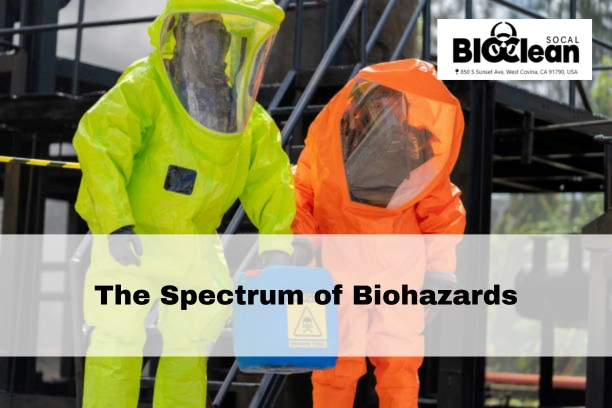
The Spectrum of Biohazards
Biohazards are not a one-size-fits-all category; they vary significantly in nature and the risks they present. Understanding these differences is key to effective biohazard management.
Description of Biohazards: From Viruses to Toxic Chemicals
Biological Agents
These include bacteria, viruses, and other microorganisms that can cause disease in humans or animals. Handling these agents requires specific biohazard cleaners trained in disinfection and sterilization techniques.
Toxic Chemicals
Chemicals that can cause harm to humans, animals, or the environment fall into this category. Proper disposal and cleanup, often managed by biohazard cleaning companies, are crucial to prevent exposure and contamination.
Pathological Waste
This encompasses human or animal body parts, blood, and bodily fluids. Crime scene cleanup teams often deal with such biohazards, following strict protocols to ensure safe disposal.
Sharps Waste
Items like needles and scalpels, which can puncture the skin and potentially spread infections, need careful handling, usually by specialized crime scene cleaners or medical waste professionals.
Classification of Biohazards Based on Risk Levels
Biohazards are classified into four levels, depending on the severity of the risk they pose:
- Level 1: Poses minimal risk to humans and the environment. Examples include non-pathogenic bacteria.
- Level 2: Includes agents that can cause diseases in humans but have limited risk of spreading. Professional biohazard cleaners can manage these with standard precautions.
- Level 3: Encompasses bacteria and viruses that can cause severe human disease and may spread, requiring specialized facilities and biohazard cleaning companies for management.
- Level 4: This category consists of pathogens that pose a high risk of life-threatening disease for which there are no vaccines or treatments. These are handled in high-security labs, not typically within the scope of standard biohazard cleaning services.
Understanding these classifications and the types of biohazards is the first step toward effective management and mitigation of these risks. A biohazard cleaning company plays a pivotal role in ensuring our environments are safe and free from these dangerous substances.
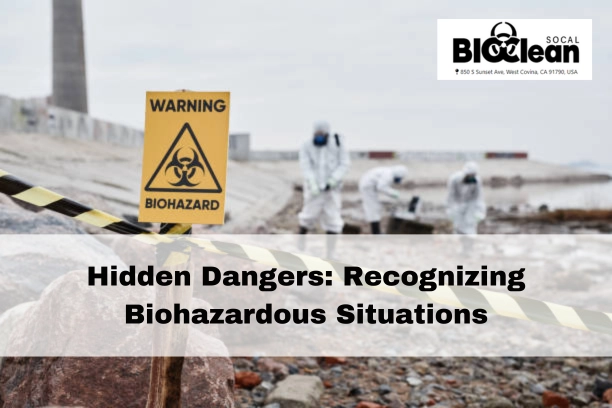
Hidden Dangers: Recognizing Biohazardous Situations
Understanding and recognizing biohazardous situations is crucial in preventing potential health risks. Various settings, such as laboratories, hospitals, and even community areas, can become hotspots for biohazardous materials if not properly managed.
Guidelines on Identifying Biohazardous Materials
- Laboratories: Look for biohazard symbols on containers, storage units, and doors. Laboratories often handle infectious agents, chemicals, and sharps, all of which require specific safety measures.
- Hospitals: Biohazardous waste, including sharps, used bandages, and surgical gloves, must be disposed of in marked containers. Hospitals are prime locations for biohazard cleaners to conduct regular cleanups to maintain a safe environment.
- Community: Unexpected situations, like hoarding scenes or abandoned waste, can pose significant biohazard risks. Hoarding cleanup services and community health workers play a vital role in identifying and mitigating these hazards.
Real-life Scenarios and Case Studies
One notable case involved a crime scene cleanup after a high-profile incident. The area was contaminated with bodily fluids, posing a significant biohazard risk. The swift action of crime scene cleaners, trained in handling such situations, was crucial in restoring safety.
Another case involved hoarding cleaners addressing a severely cluttered home, where decaying organic matter and vermin infestation presented biohazard risks. These scenarios underline the importance of recognizing and promptly addressing biohazardous situations.
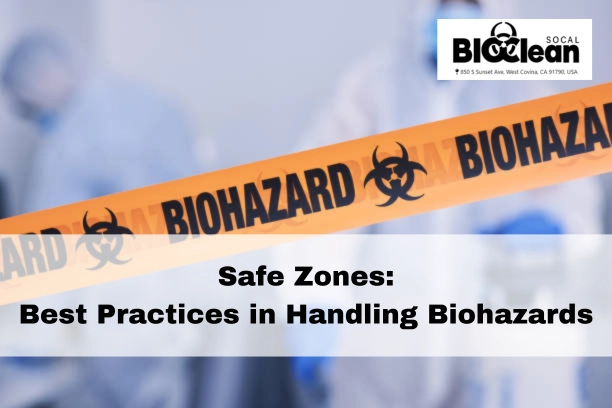
Safe Zones: Best Practices in Handling Biohazards
Creating and maintaining safe zones involves stringent adherence to safety protocols and procedures. These best practices are essential for anyone dealing with biohazardous materials, from biohazard cleaners to laboratory technicians.
Comprehensive Overview of Safety Protocols
- Understanding Risk Levels: Tailor safety measures based on the biohazard level, from minimal protective gear for low-risk situations to full hazmat suits for high-risk scenarios.
- Regular Training: Biohazard cleaning companies often provide their employees with ongoing training in the latest safety protocols and handling procedures.
Step-by-step Guidance on Using Personal Protective Equipment (PPE) and Decontamination Procedures
- PPE Selection: Depending on the type of biohazard, select appropriate PPE, including gloves, gowns, masks, and eye protection.
- Proper PPE Donning and Doffing: Follow systematic procedures for putting on and removing PPE to avoid contamination.
- Decontamination: Use approved disinfectants and follow specific protocols for cleaning tools, surfaces, and potentially exposed skin areas.
In Case of Exposure: Emergency Responses
In the event of exposure to hazardous materials, immediate action can mitigate health risks and prevent further contamination.
Instructions on Immediate Actions to Take
- Isolate the Area: Prevent further exposure by isolating the affected area until biohazard cleaners or emergency responders arrive.
- Seek Medical Attention: Immediate medical evaluation is crucial, even if no symptoms are present initially.
- Report the Incident: Notify the appropriate health authorities and emergency response teams to coordinate a proper response.
Contact Information for Health Authorities and Emergency Response Teams
Keeping a list of contacts for local health departments, biohazard cleaning companies, and emergency response teams specialized in biohazard incidents is essential for quick action. These entities are equipped to handle various biohazard scenarios, from crime scene cleanup to accidental laboratory exposures.
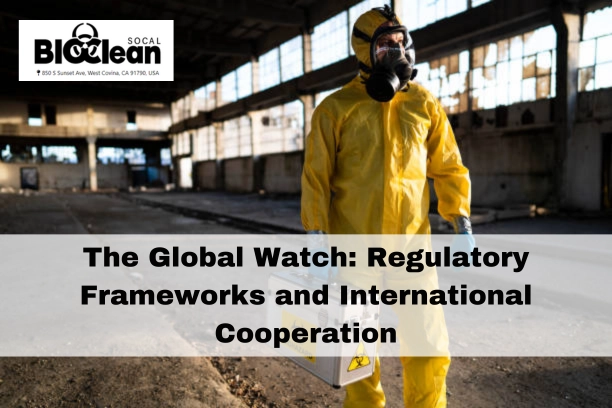
The Global Watch: Regulatory Frameworks and International Cooperation
In the intricate dance of managing biohazards, regulatory frameworks serve as the choreography, guiding nations in a unified effort to safeguard humanity and the environment from these threats.
Summarizing Key Regulations and International Standards
- Biosafety in Microbiological and Biomedical Laboratories (BMBL): Provides a cornerstone for biohazard safety in the United States, outlining best practices for the containment and management of biohazards.
- World Health Organization (WHO) Biosafety Guidelines: Offer a global perspective on handling infectious agents and promote safety measures that transcend borders.
- International Health Regulations (IHR): A binding agreement among 196 countries to enhance global public health security through better response to public health risks and emergencies.
The Imperative of Global Cooperation
- Sharing Best Practices: Nations collaborate to share insights on biohazard management, from the effectiveness of biohazard cleaning companies to advancements in crime scene cleanup technologies.
- Joint Response to Outbreaks: The global community unites to respond to biohazard emergencies, exemplifying how international cooperation can contain outbreaks and mitigate their impact.
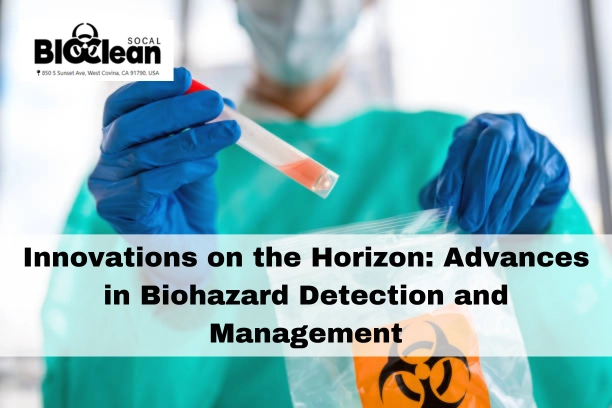
Innovations on the Horizon: Advances in Biohazard Detection and Management
As the threat landscape evolves, so too do the tools and technologies designed to detect, neutralize, and manage biohazards, heralding a new era of preparedness and response capabilities.
Cutting-Edge Technologies and Methods
- Rapid Diagnostic Tests: Facilitate the swift identification of pathogens, enabling faster intervention and containment strategies.
- Portable Detection Devices Allow for on-site identification of biohazards, which is critical in remote areas or disaster zones where traditional lab facilities are inaccessible.
- Advanced Personal Protective Equipment (PPE): Innovations in PPE, such as suits that offer enhanced mobility and protection, bolster the safety of biohazard cleaners and crime scene cleanup teams.
Emerging Trends in Biohazard Management
- Nanotechnology: Holds the promise of neutralizing biohazards at the molecular level, offering new pathways for decontamination and disinfection.
- Artificial Intelligence (AI) and Machine Learning (ML): These technologies are being leveraged to predict outbreaks, model biohazard spread, and optimize cleanup operations, representing a quantum leap in our ability to manage biohazard risks.
- Bioremediation: The use of microorganisms to degrade or neutralize pollutants, including biohazards, provides an environmentally friendly approach to cleanup operations.
Exploring global regulatory frameworks and embracing innovation underscores a collective commitment to advancing our capabilities in managing biohazards. From the meticulous work of biohazard cleaning companies to the collaborative efforts of international coalitions, these efforts are pivotal in ensuring a safer, more prepared world.
As we peer into the future, the continued fusion of technology, research, and international cooperation holds the key to unlocking unprecedented levels of biohazard detection, management, and mitigation, safeguarding humanity against the evolving threats posed by biohazards.
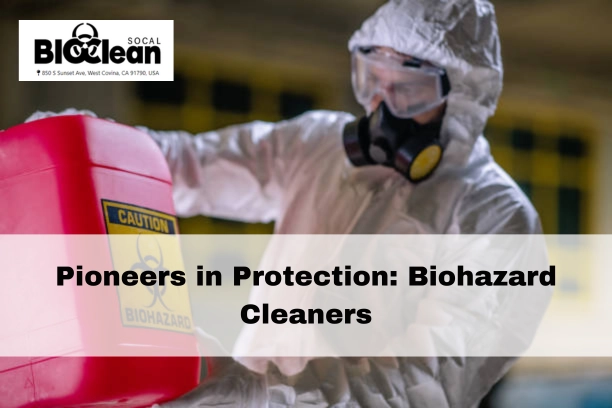
Pioneers in Protection: Biohazard Cleaners
Those who dedicate their careers to biohazard cleanup perform one of the most challenging and necessary public health and safety roles.
The World of Biohazard Cleaners: Scope and Challenges
- Diverse Environments: From hospitals and laboratories to crime scenes and private homes, biohazard cleaners work in a variety of settings, each with its own set of hazards.
- Physical and Health Risks: Handling toxic substances, infectious agents, and hazardous chemicals requires constant vigilance and adherence to safety protocols.
Mastering the Art of Biohazard Cleanup
- Specialized Training: Biohazard cleaners undergo rigorous training, learning about different types of biohazards, appropriate cleaning agents, and the most effective cleanup techniques.
- Certifications: Many cleaners hold certifications, such as OSHA’s Hazardous Waste Operations and Emergency Response (HAZWOPER), ensuring they’re prepared for high-risk environments.
- Emotional Resilience: Given the often distressing nature of their work, especially in crime scene cleanup, emotional resilience training is as crucial as physical safety training.
Navigating the Aftermath of Tragedy
In the wake of violence or accidents, crime scene cleaners step in to restore order, facing logistical challenges and the weight of human sorrow.
Beyond the Yellow Tape: The Crucial Role of Crime Scene Cleaners
- Technical Expertise: Crime scene cleaners are adept at removing hazardous biological materials, ensuring no trace of the tragedy remains to pose a risk to others.
- Coordination with Authorities: They often work closely with law enforcement and emergency services, timing their efforts to follow investigative processes.
Handling Complexity with Care
- Emotional Complexity: Crime scene cleanup often involves interactions with grieving families, requiring a compassionate and respectful approach.
- Technical Challenges: Each scene presents unique challenges, from the type of biohazard present to the extent of the cleanup required.
The Hidden Dangers of Hoarding
Hoarding scenarios are complex and sensitive situations that harbor significant biohazard risks, demanding a nuanced approach to cleanup.
Uncovering Biohazard Risks in Hoarding Situations
- Variety of Biohazards: From decomposing waste to mold and structural hazards, the range of biohazards in hoarding scenarios can be vast.
- Assessment and Strategy: Hoarding cleanup services begin with a thorough assessment to strategize the safest and most effective cleanup plan.
Restoring Safety and Dignity
- Collaborative Cleanup: The process often involves working alongside mental health professionals, social workers, and individuals to ensure a respectful and effective cleanup.
- Focus on Well-being: Beyond merely cleaning, these services aim to restore livable conditions and help individuals on the path to recovery.
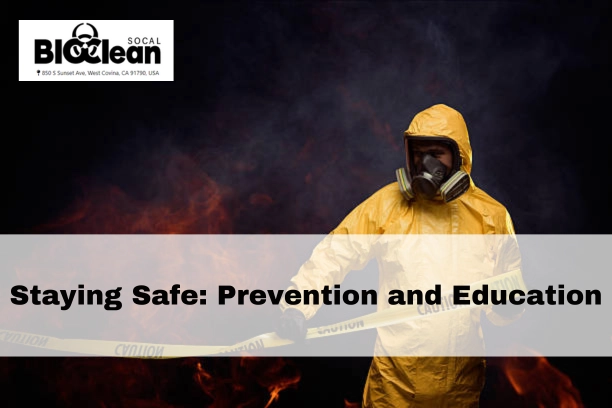
Staying Safe: Prevention and Education
Preventing exposure to biohazards is paramount. Proper precautions and continuous learning can significantly reduce the risks associated with these hazardous substances.
Minimizing Biohazard Risks: Tips for Safety
- Regular Training: Ensure employees, especially those in high-risk environments like laboratories or hospitals, receive ongoing training on safely handling biohazards.
- Proper Use of PPE: Emphasize the importance of using personal protective equipment (PPE) correctly, including gloves, masks, and protective clothing, to minimize exposure.
- Safe Disposal Practices: Implement and follow strict disposal procedures for biohazardous waste to prevent contamination and spread of infectious agents.
- Emergency Preparedness: Have clear, accessible emergency response plans for potential biohazard exposures, including immediate actions and contact information for biohazard cleaning companies.
The Role of Education and Awareness
- Ongoing Campaigns: Educational campaigns aimed at the public and specific high-risk groups can raise awareness about biohazards and the importance of prevention.
- Community Workshops: Hosting workshops and training sessions can help disseminate vital information on safely handling biohazards and the resources available for cleanup, such as crime scene cleaners and hoarding cleanup services.

Conclusion: Call to Action
The journey through the world of biohazards highlights the complexity and importance of recognizing, identifying, and safely managing these risks. Biohazards, whether in the form of infectious agents, chemical spills, or situations requiring crime scene cleanup, pose significant challenges to public health and safety.
As we’ve explored, the roles of biohazard cleaning companies, crime scene cleanup teams, and hoarding cleanup services are critical in mitigating these risks. However, the responsibility doesn’t rest solely on these professionals. It extends to each individual and organization, underscoring the importance of prevention, proper education, and adherence to safety protocols.
- Engage in Continuous Learning: Stay informed about the best practices for biohazard safety and the latest advancements in biohazard management.
- Follow Safety Protocols: Diligently adhere to established safety guidelines and procedures when handling biohazards or encountering potential biohazardous situations.
- Participate in Awareness Programs: Get involved in or initiate community awareness programs to spread knowledge about the risks associated with biohazards and the importance of cleanup services.
By fostering a culture of safety, education, and cooperation, we can collectively enhance our resilience to biohazard threats. Let’s commit to ongoing education, comply with safety protocols, and actively participate in community efforts to ensure a safer environment.
This comprehensive exploration of biohazards, from their identification and management to the vital work of those cleaning and restoring safety, emphasizes our collective responsibility in facing these challenges. Together, through awareness, education, and adherence to safety measures, we can mitigate the risks and protect public health and safety.
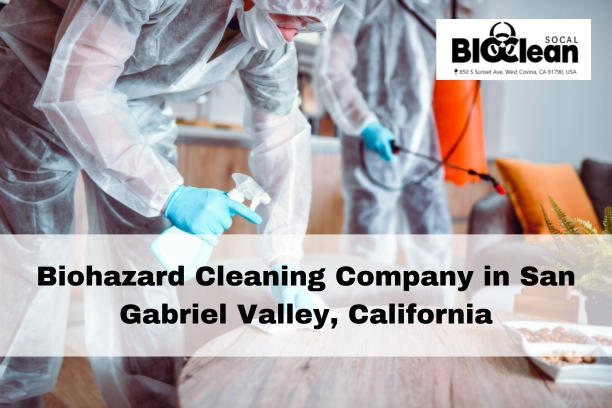
Biohazard Cleaning Company in San Gabriel Valley, California
In the complex world of biohazard risks, from unforeseen accidents to environmental hazards, the need for expert cleanup services is more critical than ever. Bioclean Socal stands at the forefront of safeguarding the San Gabriel Valley community, offering comprehensive biohazard cleanup solutions. Our team of certified professionals is equipped with specialized skills and training to handle all levels of biohazardous situations, ensuring your safety and peace of mind. Whether it’s crime scene residues, hoarding scenarios, or infectious outbreaks, Bioclean Socal responds with prompt, compassionate, and efficient service. Trust us to restore your environment to a safe and healthy condition. Call now at (626) 986-6438.
Read more
Comprehensive Guide to Biohazard Cleaning Company: Services and Standards



